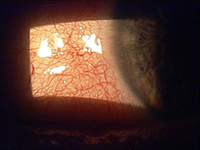| |
|
| Vol. 2, #10 • Friday, May 21, 2021 |
|
|
|
|
| |
|
Review's Chief Clinical Editor
Paul M. Karpecki, OD, FAAO
Provides you with cutting-edge clinical strategies for optimal management of ocular surface disease and beyond.
|
|
|
|
|
|

Hyperemia |
|
As the Tear Film and Ocular Surface Society's (TFOS) DEWS II report instructs, the key to a diagnosis of dry eye is the combination of signs and symptoms.
This makes sense because if, for example, a patient is presenting with only the sign of significant punctate epithelial keratitis but no symptoms, this finding would indicate a neurotrophic keratitis. On the other hand, the extreme case of chronic ocular surface pain (COSP)—also known as corneal neuralgia or neuropathic chronic pain—is a diagnosis made with excessive symptoms but no signs (i.e., “pain without stain”). Dry eye has to include some degree of both signs and symptoms.
The most common symptom of dry eye is that eyes feel dry! No surprise there, but other symptoms can include burning or stinging, foreign body sensation, grittiness, itching, contact lens intolerance, photophobia and pain/discomfort. Two other key symptoms I want to address individually are blurred vision and hyperemia.
Blurred Vision. Make no mistake that dry eye is a vision-related condition and may be a common cause of spectacle remakes or IOL miscalculations. Initially and in cases of MGD/evaporative dry eye disease (EDED), patients may complain of fluctuating vision. If a patient needs to blink to clear their vision, this is a strong indication of MGD or EDED. A more constant blur could also be related to dry eye if especially central superficial punctate keratopathy (SPK) is noted.
Hyperemia. Red eye is a bothersome sign for patients as it can create feelings of self-consciousness about the appearance of the eyes. However, it’s also a great indicator of the presence of inflammation. In the pivotal FDA trial for EYSUVIS (Kala Pharmaceuticals), researchers included conjunctival hyperemia as a prespecified primary endpoint in STRIDE 1 and STRIDE 2, and a prespecified secondary endpoint in STRIDE 3. EYSUVIS was able to show a statistically significant improvement in hyperemia in patients with DED over vehicle.1,2
|
|
|
|
KEY TAKEAWAY: When considering the diagnosis of dry eye, in addition to symptoms such as eye dryness, burning and grittiness, also assess for blurred vision and hyperemia, as those are hallmarks of DED and the presence of inflammation.
1. Holland E, Nichols K, Foulks G, et al. Safety and efficacy of KPI-121 ophthalmic suspension 0.25% for dry eye disease in four randomized controlled trials. Presented at: AAO 2020: November 13-15, 2020; virtual meeting.
2. Data on file. Kala Pharmaceuticals. Watertown, MA.
|
|
|
|
| Supported by an independent medical grant from Kala Pharmaceuticals |
|
|
| |
Review of Optometry® is published by the Review Group, a Division of Jobson Medical Information LLC (JMI), 19 Campus Boulevard, Suite 101, Newtown Square, PA 19073.
To subscribe to other JMI newsletters or to manage your subscription, click here.
To change your email address, reply to this email. Write "change of address" in the subject line. Make sure to provide us with your old and new address.
To ensure delivery, please be sure to add revoptom@lists.jobsonmail.com to your address book or safe senders list.
Click here if you do not want to receive future emails from Review of Optometry. |
|
|
|
|
|
|
|
|